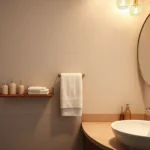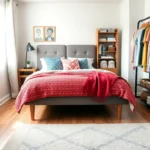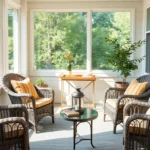Your front yard serves as the first impression guests get of your home – and we all know how crucial first impressions can be. Whether you’re looking to boost your property’s curb appeal or create a welcoming entrance that reflects your personal style, the right landscaping design can transform your outdoor space from ordinary to extraordinary.
We’ve seen countless homeowners struggle with turning their front yard vision into reality. From selecting the perfect plants that thrive in your climate to creating balanced compositions that complement your home’s architecture, front yard landscaping involves more strategic planning than many people realize.
That’s why we’ve compiled the most effective front yard landscaping design ideas that’ll help you create a stunning outdoor space without very costly. These proven strategies will guide you through everything from foundation plantings to pathway designs, ensuring your front yard becomes the neighborhood standout you’ve always wanted.
Create Stunning Curb Appeal With Modern Minimalist Front Yard Designs
Modern minimalist front yard designs transform your home’s exterior into a sophisticated showcase that commands attention. We’ll explore three essential elements that create contemporary curb appeal while maintaining simplicity and elegance.
Clean Lines and Geometric Plantings
Structured plantings define modern minimalist landscapes through their precise arrangement and architectural appeal. We recommend using boxwood hedges trimmed into perfect rectangles or spheres to create visual boundaries around your front entrance. Square planters filled with ornamental grasses like fountain grass or blue fescue add height variation while maintaining clean edges.
Linear flower beds work exceptionally well when planted parallel to walkways or home foundations. Create striking patterns by alternating between two plant varieties such as white roses and silver lamb’s ear, spacing them exactly 18 inches apart for consistency. Geometric raised beds made from steel or composite materials elevate your plantings while adding contemporary structure.
Symmetrical arrangements bring balance to your front yard through strategic plant placement. Position identical shrubs like Japanese yews on either side of your front door to frame the entrance. Repeat this symmetry with matching planters or identical plant groupings throughout your industry design.
Strategic Use of Hardscaping Materials
Concrete pavers create clean pathways that complement minimalist aesthetics while providing durable functionality. We suggest using large format pavers in neutral colors like charcoal gray or warm beige, arranging them in simple running bond or stacked patterns. These materials require minimal maintenance and withstand weather conditions for decades.
Natural stone elements add texture without overwhelming your design’s simplicity. Incorporate limestone or sandstone walls as retaining features or property borders, keeping heights under 3 feet to maintain openness. River rock mulch provides excellent drainage while creating smooth transitions between planted areas and hardscaping.
Metal accents introduce contemporary touches through carefully selected decorative elements. Install weathering steel planters that develop attractive patina over time, or add aluminum edging to separate lawn areas from garden beds. These materials create sharp definition while contributing to your yard’s modern aesthetic.
Low-Maintenance Native Plant Selection
Drought tolerant perennials reduce watering requirements while providing year round interest in minimalist landscapes. We recommend purple coneflowers, black eyed susans, and sedum varieties that thrive in most climate zones with minimal care. These plants establish strong root systems and return annually without replanting.
Evergreen shrubs maintain your industry’s structure throughout all seasons while requiring little maintenance. Choose compact varieties like dwarf Alberta spruce or mugo pine that won’t outgrow their designated spaces. Position these anchor plants at key focal points to create consistent visual weight.
Ornamental grasses move gracefully in breezes while adding textural contrast to your minimalist design. Plant feather reed grass or maiden grass in groups of three or five for maximum impact. These grasses require only annual cutting and provide beautiful seed heads during winter months.
Transform Your Entrance With Colorful Flower Garden Layouts
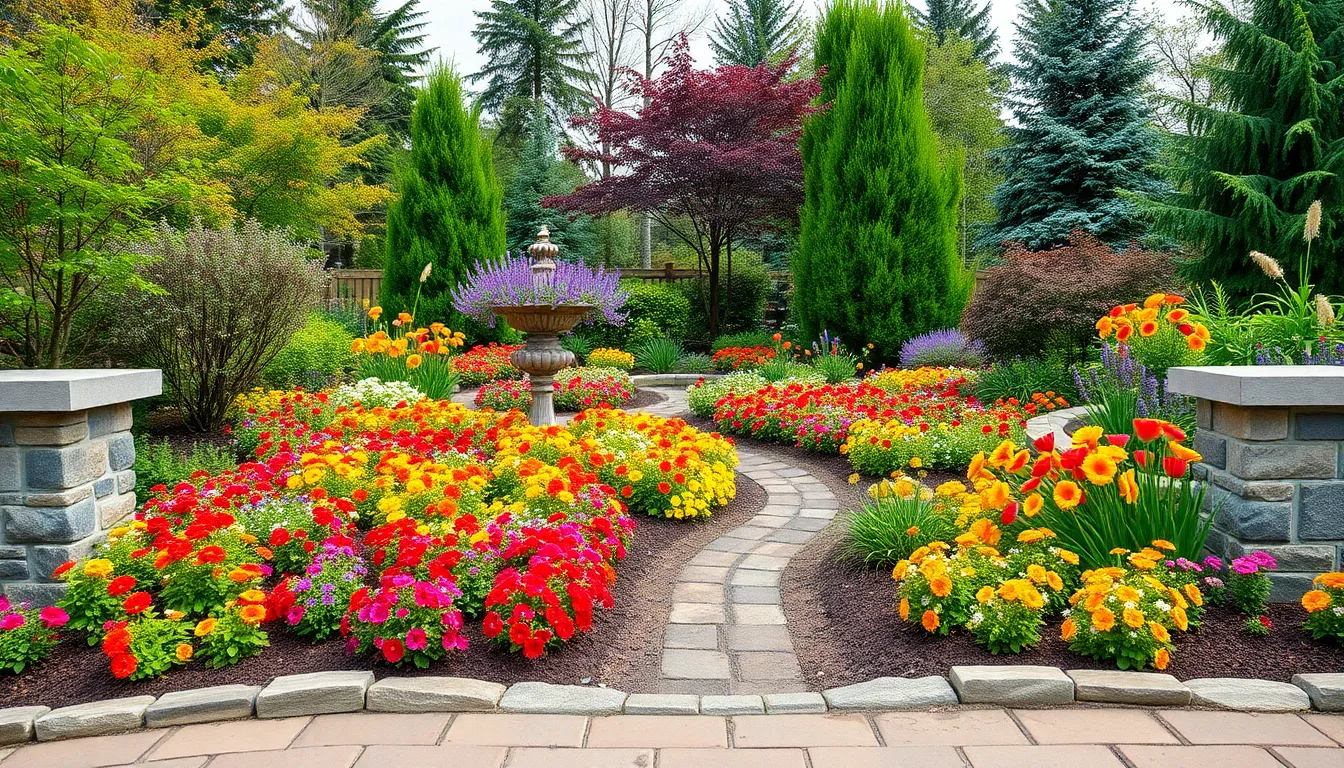
We believe colorful flower gardens create the most welcoming entrance to any home. Creating a flower-filled entrance with vibrant annuals and perennials delivers year-round color and maximum visual impact.
Seasonal Blooming Plant Combinations
Seasonal blooms maintain visual interest throughout every season when we select plants that flower at different times. Spring-blooming bulbs like crocus and daffodils pair beautifully with summer perennials such as coneflowers and black-eyed Susans. Fall flowers including asters and ornamental kale extend the growing season while evergreens provide winter structure.
We recommend combining tulips for early spring color with daylilies that bloom through summer heat. Mums add rich autumn tones that complement the changing season. Mixed planters and hanging baskets near doorways provide extra bursts of seasonal color and create welcoming details that draw visitors toward the entrance.
Layered Height Arrangements for Visual Interest
Layered plantings using tall trees, medium shrubs, and low-growing perennials create depth and rich texture in entrance gardens. We place Japanese maples or small ornamental trees at the back of planting beds for vertical interest. Mid-height shrubs like boxwood and hydrangea fill the middle layer with structure and seasonal blooms.
Groundcovers and flowering perennials occupy the front layer where they’re easily visible from the street. This three-tier approach makes landscapes appear lush and full while ensuring every plant receives proper sunlight. Strategic placement prevents taller plants from overshadowing shorter specimens and creates natural viewing angles.
Border and Edge Definition Techniques
Clear borders and defined edges provide the polished look that elevates any flower garden design. We use materials such as brick, stone, or metal edging to separate flower beds from lawn areas and pathways. Mulch between planted areas adds visual contrast while suppressing weeds and retaining soil moisture.
Pavers and stepping stones guide visitors naturally toward the entrance while creating functional walkways. Low-maintenance options include decorative gravel borders and spreading groundcovers like creeping juniper that soften hard edges. These definition techniques frame colorful plantings and create organized spaces that enhance overall curb appeal.
Incorporate Natural Stone Elements for Timeless Elegance
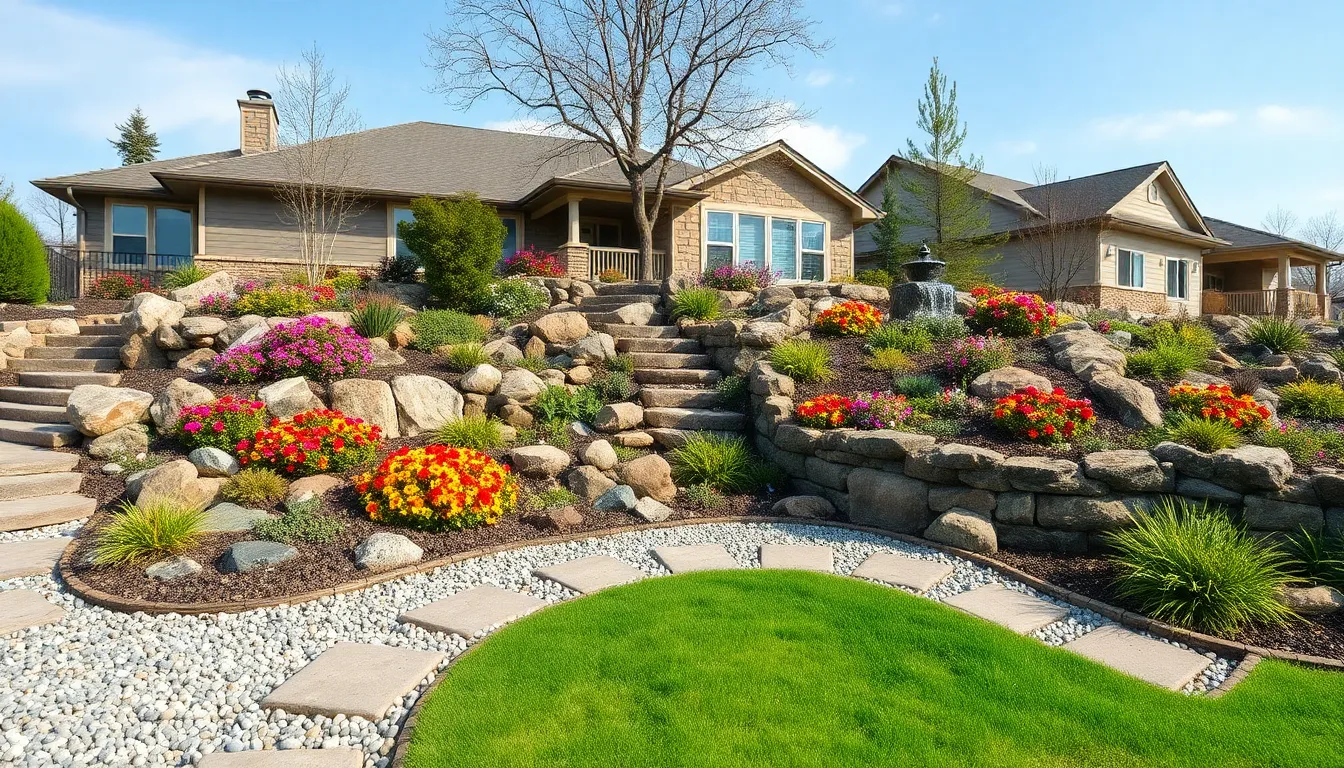
Natural stone elements bring enduring beauty and sophisticated structure to front yard landscapes while seamlessly complementing various architectural styles.
Decorative Rock Gardens and Gravel Paths
Rock gardens paired with gravel pathways offer the perfect solution for homeowners seeking low-maintenance landscaping options that remain beautiful year-round. These design elements work exceptionally well in drought-prone areas where traditional grass and high-water plants struggle to thrive.
Creating modern, eco-friendly designs becomes effortless when we combine native plants and drought-tolerant ground covers with decorative rocks of varying sizes and textures. Gravel paths provide an affordable alternative to traditional paving materials while offering practical benefits like reduced water runoff and improved soil erosion control.
Selecting decorative stones in complementary colors enhances the overall aesthetic while maintaining the natural, organic feel that makes rock gardens so appealing. We recommend using local stone varieties when possible, as they’ll naturally blend with the surrounding environment and often cost less than imported options.
Stone Retaining Walls and Raised Beds
Stone retaining walls transform challenging sloped yards into functional, terraced landscapes that prevent erosion while creating ideal planting opportunities. These practical structures solve drainage issues common in front yards with uneven terrain while adding important visual appeal.
Raised beds constructed from natural stone materials add impressive vertical interest and provide superior growing conditions for flowers, shrubs, and even vegetable gardens. The elevated planting areas improve soil drainage and make garden maintenance much easier for homeowners.
Defining garden spaces becomes natural when we incorporate stone walls and raised beds into our industry design. These permanent structures create a sense of order and sophistication that transforms ordinary front yards into organized, professional-looking outdoor spaces.
Water Feature Integration With Natural Materials
Water features clad in natural stone create cohesive, tranquil focal points that enhance any front yard’s welcoming atmosphere. Stone fountains, ponds, and cascades provide the soothing sounds of moving water while introducing calming elements that visitors notice immediately.
Integrating these features using natural materials ensures they blend seamlessly with surrounding industry elements rather than appearing as afterthoughts. We find that stone-clad water features paired with lush plantings create the most effective restorative, natural ambiance.
Maintaining visual harmony becomes easier when water features incorporate the same stone materials used elsewhere in the industry design. This thoughtful approach creates a unified look that feels intentional and professionally designed throughout the entire front yard space.
Design Functional Walkways That Welcome Guests
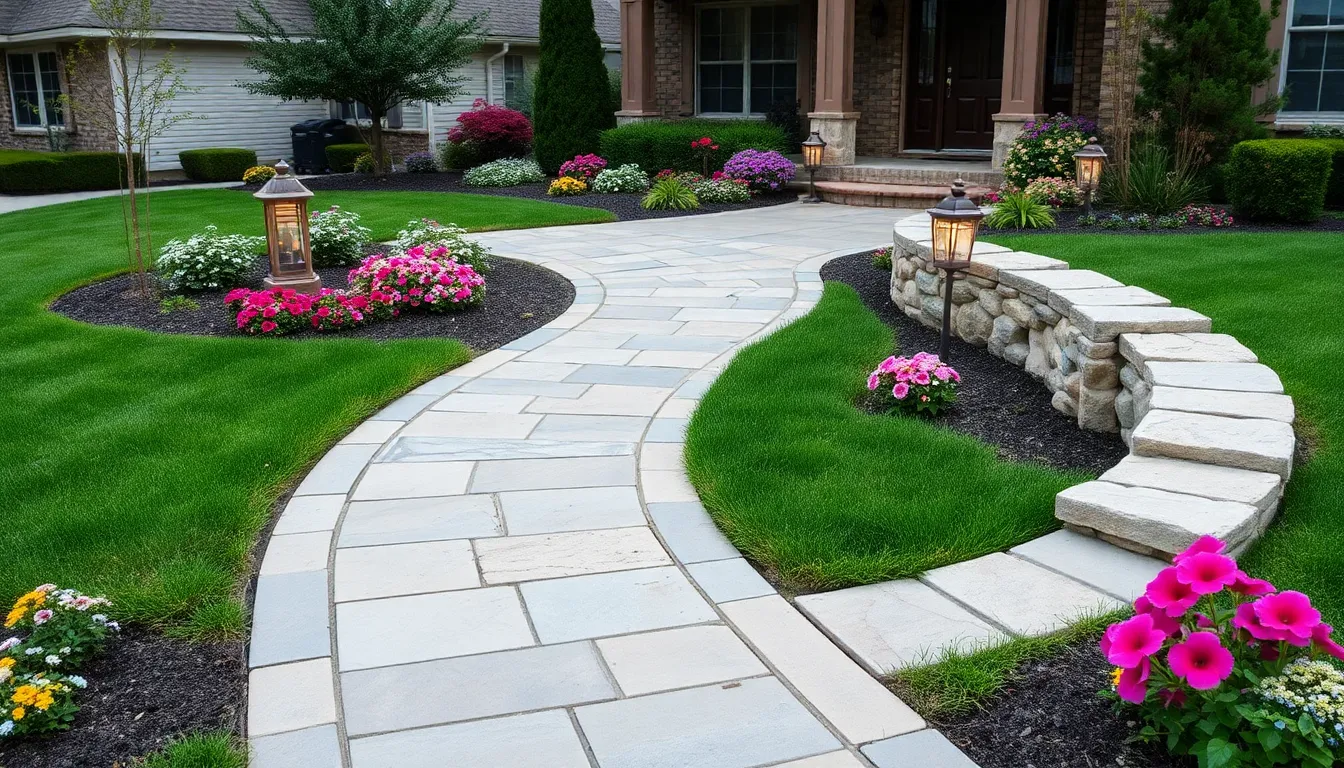
We believe functional walkways serve as the backbone of welcoming front yard design. Creating paths that guide visitors safely while improving your home’s overall aesthetic requires careful planning and attention to detail.
Curved Pathway Design Principles
Curved pathways create a sense of movement and discovery that draws guests naturally toward your entrance. We recommend using your yard’s natural contours to determine the curve’s shape for the most seamless integration with your industry. Gentle curves prove both visually appealing and safer than sharp angles that can catch visitors off guard.
Planning your curved path becomes easier when you lay out the route with string or a garden hose before installation. This technique ensures smooth transitions and proper flow toward your home’s entrance. We find curved paths especially effective in sloped or irregularly shaped yards where straight lines might look awkward or unnatural.
Natural movement through your industry emerges when curves follow existing terrain features like trees, slopes, or garden beds. Strategic placement creates visual interest while maintaining functionality for daily use.
Material Choices for Different Home Styles
Material selection significantly impacts both durability and aesthetic appeal of your walkway design. We’ve identified key combinations that work best for exact architectural styles:
| Home Style | Recommended Materials | Design Benefits |
|---|---|---|
| Traditional/Colonial | Pavers and brick | Classic appeal, long-lasting durability |
| Rustic/Cottage | Gravel pathways | Informal charm, easy maintenance |
| Modern/Minimalist | Concrete or stone slabs | Clean lines, contemporary look |
| Versatile/Mixed | Stepping stones | Flexible design, natural integration |
Stepping stones offer exceptional flexibility for diverse home styles, particularly when you choose natural shapes and complement them with planted borders. We recommend selecting materials that complement your home’s existing colors and textures for the most cohesive appearance.
Durability considerations become crucial when choosing between materials, as high traffic areas require more robust options than decorative accent paths.
Lighting Integration for Safety and Ambiance
Strategic lighting placement transforms walkways into safe, inviting passages that extend your outdoor space’s usability after dark. We suggest incorporating path lights, uplights, and downlights to improve safety while highlighting key industry features throughout your front yard.
Solar powered options provide low maintenance answers that eliminate electrical work and reduce ongoing energy costs. Position lights along walkways, near steps, and at focal points like mature trees or architectural features for maximum impact.
Warm or soft white LED bulbs create the ideal ambiance while ensuring adequate nighttime visibility for guests. We find that lighting enhances entryways most effectively when fixtures complement your home’s architectural style and existing outdoor elements.
Safety becomes paramount when illuminating changes in elevation, curves, or transitions between different walkway materials. Proper spacing ensures consistent coverage without creating harsh shadows or overly bright spots that might affect night vision.
Add Vertical Interest With Strategic Tree Placement
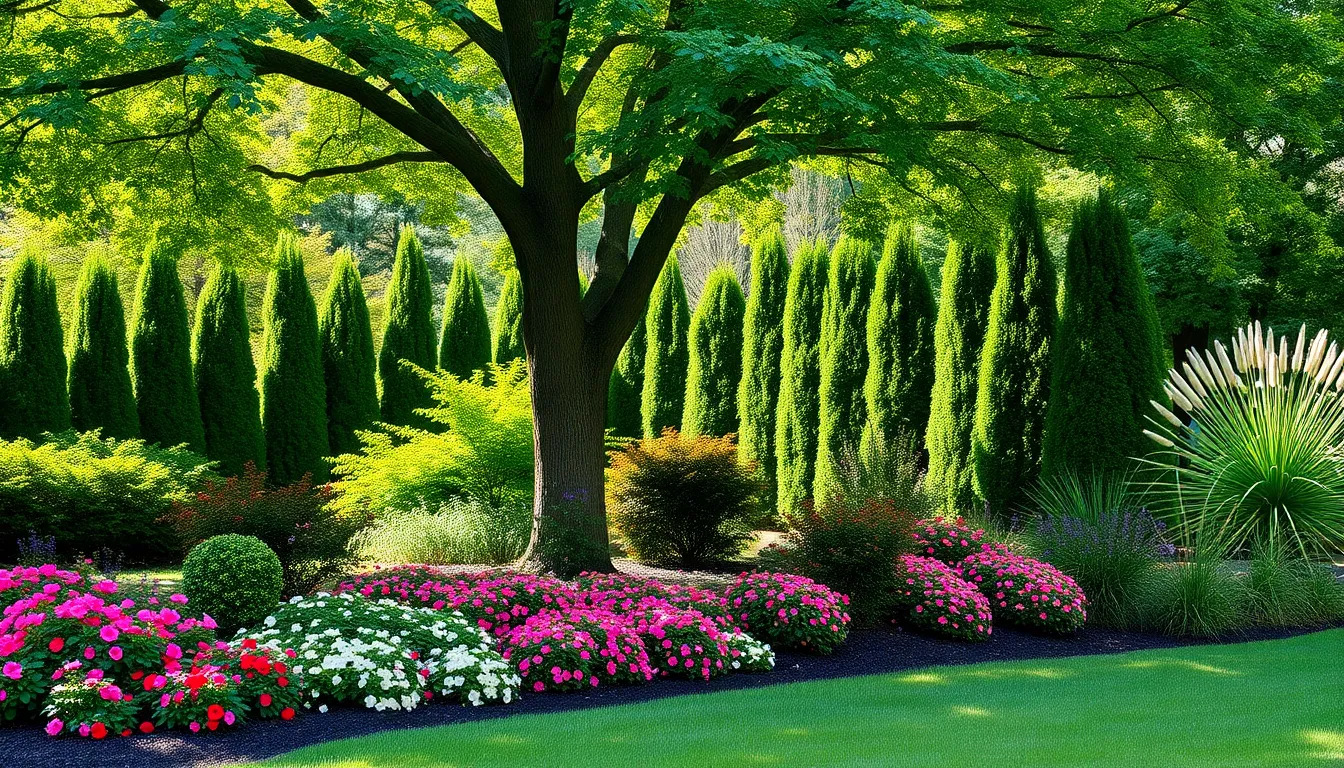
Strategic tree placement transforms flat front yards into ever-changing landscapes with multiple layers and compelling focal points. Trees create the essential vertical framework that anchors your entire landscaping design.
Foundation Planting Around Existing Trees
Foundation plantings around established trees create cohesive industry anchors that tie your entire front yard together. We recommend selecting shrubs and perennials that harmonize with your tree’s mature size and canopy density to maintain visual balance throughout the seasons.
Choose complementary plants that won’t compete with your tree’s root system or overwhelm its natural beauty. Low-growing hostas work perfectly under shade trees, while colorful azaleas thrive beneath partially shaded canopies. Evergreen shrubs like boxwood provide year-round structure and frame deciduous trees beautifully.
Layer different heights to create depth and visual interest around your tree’s base. Start with taller shrubs closest to the trunk, then graduate to medium-height perennials, and finish with groundcover plants at the outer edges. This graduated approach mimics natural forest environments and creates a soft, layered effect that echoes your tree’s foliage colors.
Maintain proper spacing between plantings and tree trunks to ensure healthy growth for all plants. Most foundation plantings should be positioned at least 3-4 feet from large tree trunks to avoid root competition and allow adequate air circulation.
Small Ornamental Tree Selection Guide
Small ornamental trees add seasonal color and structural interest without overwhelming compact front yard spaces. We focus on climate-appropriate species that complement your home’s architectural style and yard scale.
Dogwoods offer spectacular spring blooms and vibrant fall foliage, making them ideal centerpiece trees for traditional home styles. These trees typically reach 15-25 feet at maturity and provide excellent four-season interest with their distinctive branching patterns and colorful bark.
Japanese maples deliver unmatched foliage diversity with varieties featuring red, purple, or variegated leaves that create stunning living sculptures. Their compact size (8-20 feet) and graceful branching make them perfect for smaller yards or as accent trees near entrances.
Crape myrtles provide extended summer blooms in colors ranging from white to deep purple, plus attractive exfoliating bark for winter interest. These drought-tolerant trees adapt well to various soil conditions and maintain a manageable size for most residential landscapes.
Plant trees at safe distances from your home’s foundation and utility lines to prevent future structural issues. Most small ornamental trees need at least 10-15 feet of clearance from buildings and underground utilities for healthy long-term growth.
Creating Natural Privacy Screens
Natural privacy screens using fast-growing shrubs, perennial grasses, or strategically spaced trees provide functional beauty while softening hard lines between your yard and street. Living barriers support local biodiversity and enhance your industry’s year-round visual appeal.
Arborvitae creates dense, evergreen screening that grows quickly and maintains its privacy function throughout winter months. These versatile conifers can be planted as formal hedges or allowed to grow naturally for a more relaxed appearance, reaching heights of 10-40 feet depending on the variety.
Ornamental grasses offer seasonal movement and texture while providing visual screening at lower heights. Tall varieties like miscanthus and fountain grass create effective barriers that sway gracefully in breezes and turn golden in fall for added seasonal interest.
Climbing vines on trellises maximize vertical space in narrow areas where traditional shrubs won’t fit. Fast-growing options like clematis, honeysuckle, or climbing roses can quickly cover structures while adding fragrance and blooms to your privacy solution.
Tightly spaced trees form living hedges that provide substantial screening while maintaining a more formal appearance than shrub barriers. Plant trees 4-6 feet apart to create solid coverage while allowing each tree enough space to develop properly.
Maximize Small Front Yard Spaces With Smart Design
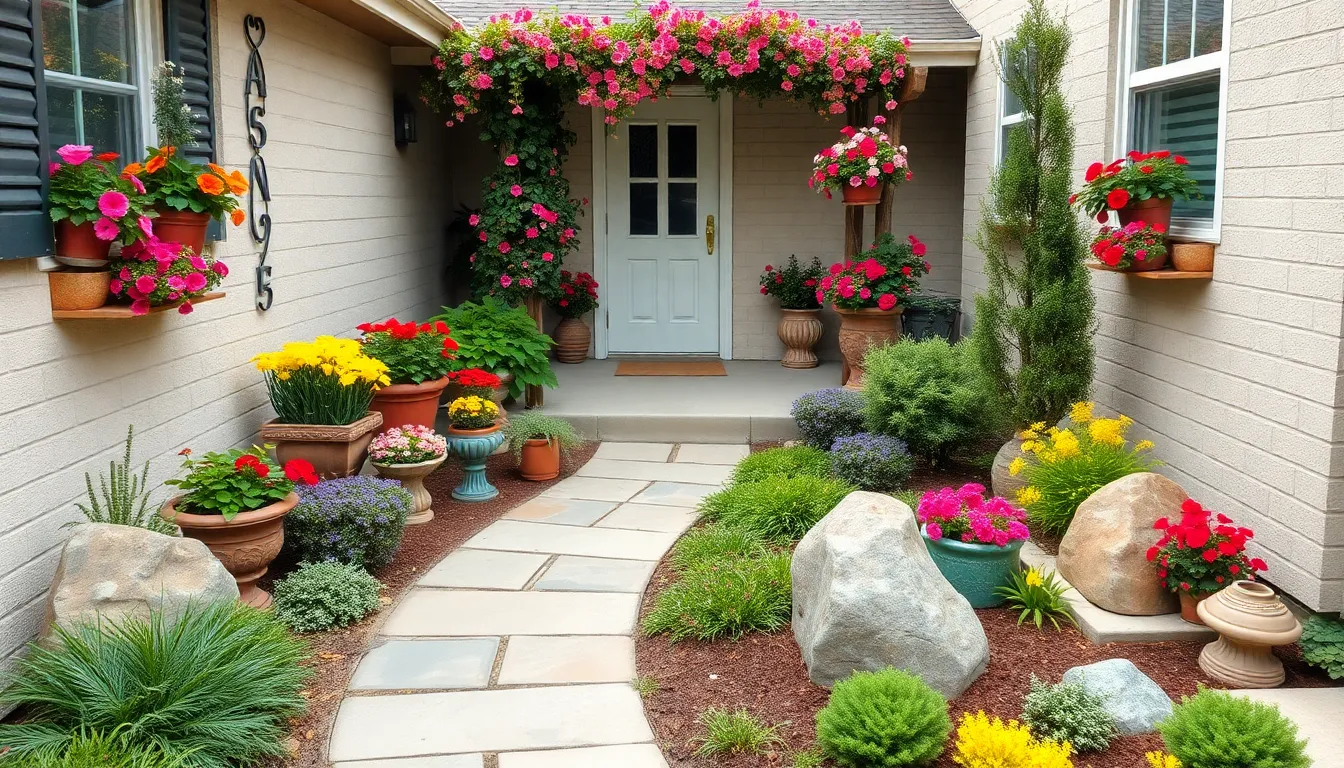
We can transform even the tiniest front yards into stunning outdoor spaces through strategic planning and creative design answers. Smart placement of fewer focal points prevents overwhelming the limited space while maximizing visual impact.
Container Gardening Answers
Flexibility becomes our greatest advantage when we choose container gardening for small front yards, allowing easy rearrangement and seasonal updates throughout the year. Containers accommodate perennials, annuals, or small trees while adding color and texture without permanent commitment to exact locations.
Grouping pots of different sizes creates visual interest along walkways and near entryways, maximizing our limited ground space effectively. Mixing shapes and heights in our container arrangements draws the eye through the industry and prevents monotonous displays.
Poor soil conditions don’t limit our options when we use containers for spaces with challenging growing conditions or minimal planting beds. We can control soil quality, drainage, and plant placement while maintaining the flexibility to adapt our design as seasons change.
Vertical Growing Techniques
Climbing plants expand our planting opportunities by utilizing walls, trellises, and existing fences for additional growing space. Ivy, clematis, and flowering vines add greenery and blooms at eye level, making small spaces feel lush and inviting throughout growing seasons.
Wall mounted planters provide extra surfaces for flowers, herbs, and small vegetables, further maximizing our available space while improving curb appeal. Hanging baskets create layers of visual interest without consuming precious ground space in compact yards.
Layered landscaping draws the eye upward when we combine low growing ground cover, mid level shrubs, and taller focal plants or trees. This vertical approach makes our yard appear larger while creating depth and dimension in limited square footage.
Multi-Purpose Landscaping Elements
Seating built into retaining walls doubles as both functional resting spots and attractive landscaping features, maximizing utility in small front yards. These integrated elements serve multiple purposes while maintaining clean lines and avoiding clutter.
Decorative boulders serve multiple functions as borders, informal seating, and striking focal points while supporting proper drainage and soil retention. Stones provide structure and visual weight without overwhelming compact spaces or requiring ongoing maintenance.
Edible landscaping combines beauty with practicality when we integrate ornamental and edible plants in the same growing areas. This approach offers both aesthetic appeal and practical harvests, ensuring every part of our small front yard contributes to both form and function.
Establish Year-Round Beauty With Evergreen Foundations
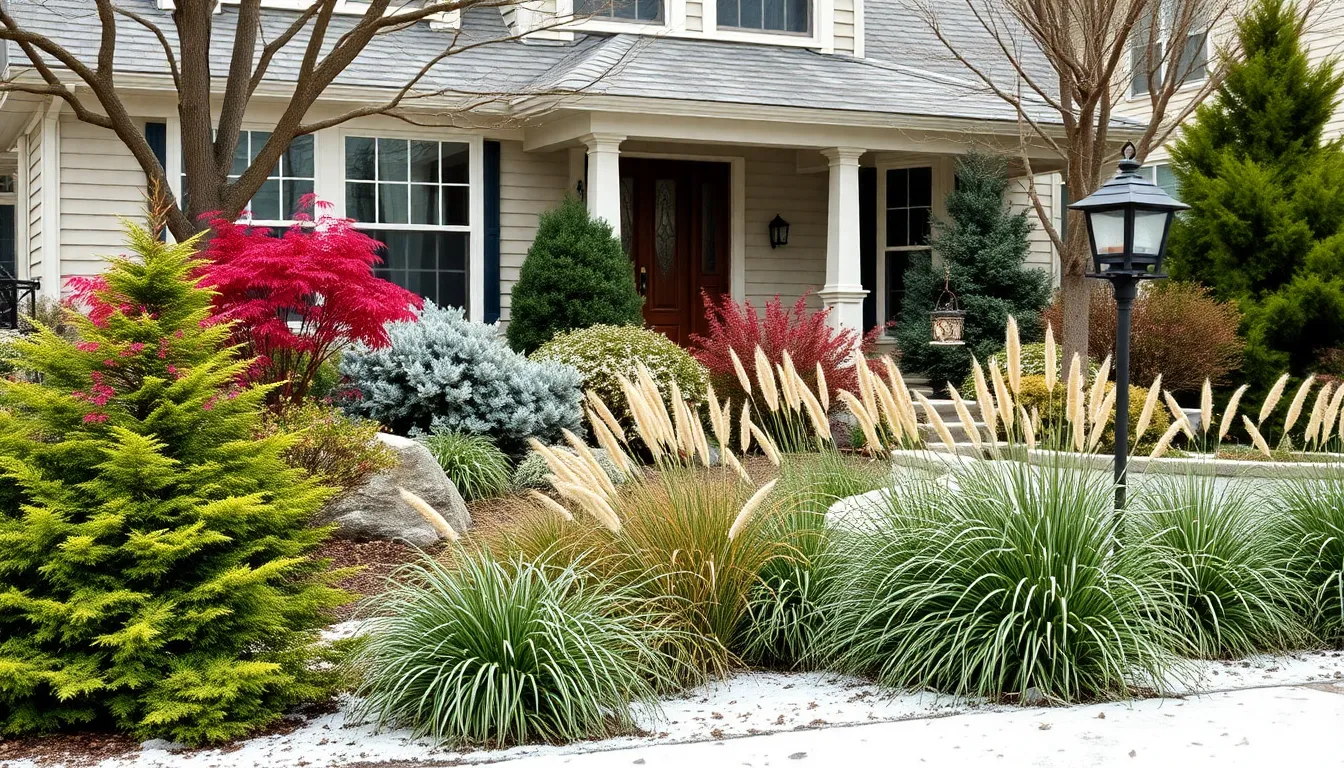
Creating a front yard that maintains its appeal through every season requires strategic planning with evergreen elements. We’ll explore how evergreen trees and shrubs like Japanese maples, cotoneaster, juniper, and arborvitae provide the structural backbone for consistently beautiful landscaping throughout the year.
Selecting the Right Evergreen Varieties
Climate considerations should guide your evergreen selection process to ensure long-term success. We recommend researching your local hardiness zone and choosing varieties that thrive in your exact climate conditions rather than struggling against environmental challenges.
Size planning becomes crucial when selecting evergreens since these plants will be permanent fixtures in your industry. Consider the mature height and spread of each variety to avoid overcrowding or blocking windows and walkways as they grow.
Growth rate analysis helps determine which evergreens match your timeline expectations. Fast-growing varieties like arborvitae provide quicker results while slower-growing options like Japanese maples offer more controlled development over time.
Balancing Textures and Colors
Mixed plantings create ever-changing visual interest by combining different plant types in layered arrangements. We suggest pairing evergreen trees with shrubs, perennials, and groundcovers to achieve depth and dimension that prevents monotonous flat appearances.
Textural contrast emerges when we combine fine-needled evergreens like juniper with broad-leafed varieties such as cotoneaster. This variety prevents visual boredom and adds sophisticated complexity to your foundation design.
Color diversity throughout the seasons maintains engagement even when flowers aren’t blooming. Incorporating plants with varied foliage colors alongside flowering specimens ensures your industry offers visual appeal during every month of the year.
Winter Interest Design Strategies
Ornamental grasses serve as excellent winter hedges or accent features when other plants become dormant. Perennial grasses provide movement and texture during cold months while requiring minimal maintenance throughout the season.
Winter blooming plants extend your garden’s active season by providing color during traditionally barren months. Species like winter aconite and snowdrops push through snow to deliver unexpected bursts of color when most landscapes appear lifeless.
Decorative elements enhance winter appeal through non-plant features that maintain visual interest year-round. Adding bird feeders, lanterns, or outdoor sculptures creates focal points that remain attractive even when surrounding vegetation enters dormancy.
Integrate Outdoor Lighting for Enhanced Evening Appeal
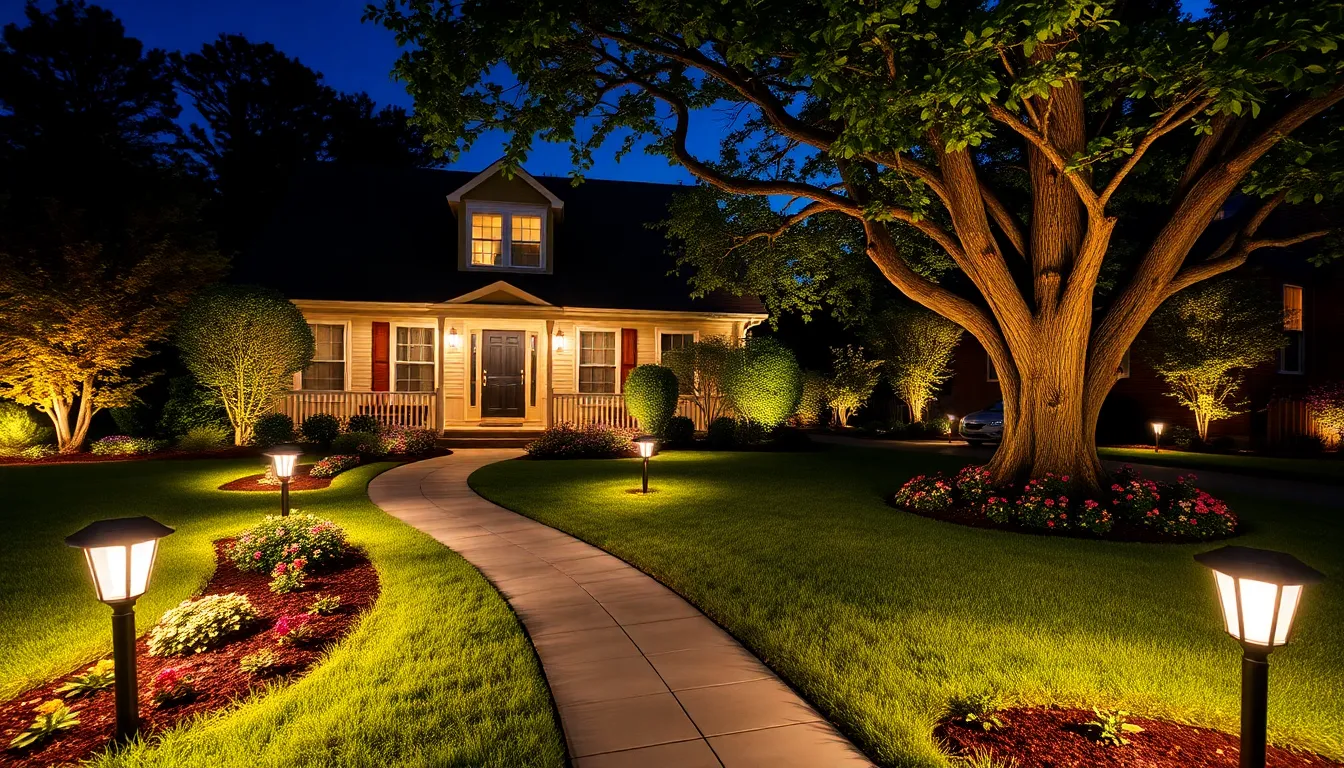
We transform front yards into captivating evening displays through strategic lighting placement that enhances both beauty and functionality. Thoughtfully planned outdoor lighting extends the usability of our outdoor spaces while creating inviting atmospheres that promote security and safety.
Pathway and Accent Lighting Options
Perimeter pathway lights serve as essential safety features in front yard landscaping, guiding visitors safely from the street to our front door while preventing accidents. Solar powered and low voltage LED options offer popular answers for their ease of installation and versatility across different industry designs.
Ground lights brighten planters and garden beds with subtle illumination that creates gentle visual boundaries without overwhelming the natural beauty of our plantings. We strategically position these fixtures to cast soft glows that enhance the layered textures of flower beds and foundation plantings.
Spotlights and well lights direct focused attention toward exact plants, sculptures, or water features, drawing the eye to industry highlights while adding dimensional depth to our outdoor spaces. These accent lighting answers work particularly well when highlighting specimen trees or architectural garden elements that deserve special recognition.
Highlighting Key Industry Features
Uplights and downlights accentuate textures and forms in landscaping by casting dramatic shadows that emphasize the architectural qualities of mature trees and unique plantings. We position these fixtures to create focal points that showcase the natural beauty of our carefully selected industry elements.
Targeted lighting illuminates mature trees and distinctive plantings, helping establish visual hierarchy within our front yard design while ensuring safety along walkways and steps. Spotlighting tall trees creates striking silhouettes against evening skies, while ground lighting within flower beds reveals the intricate details of our plant selections.
Lighting steps and retaining walls ensures visitor safety while adding dimensional interest to hardscaping features that might otherwise disappear into darkness. We use consistent lighting themes to create cohesive, inviting atmospheres that seamlessly blend functional illumination with aesthetic enhancement.
Energy-Efficient Lighting Answers
Solar powered LED fixtures reduce energy consumption and maintenance requirements while providing consistent illumination throughout evening hours. These sustainable lighting options feature customizable settings and long lasting performance, making them ideal choices for environmentally conscious landscaping projects.
Smart automation systems offer advanced control over our outdoor lighting, allowing us to adjust brightness levels and timing schedules based on seasonal changes and exact usage needs. Modern lighting technology includes motion sensors and programmable timers that optimize energy efficiency while maintaining security coverage.
DIY installation options enable homeowners to update their front yards without professional assistance, as many contemporary lighting fixtures are designed for quick setup and straightforward wiring connections. Low voltage systems provide safer installation processes while delivering professional quality results that enhance curb appeal and property value.
Conclusion
Transforming your front yard doesn’t have to be overwhelming or expensive. With the right combination of design elements—from evergreen foundations and colorful seasonal displays to strategic lighting and functional walkways—you can create an outdoor space that reflects your style while boosting your home’s value.
Remember that successful landscaping is about balance. Whether you’re working with a sprawling lawn or a compact urban space the key is choosing elements that work together harmoniously. Start with one focal area and gradually expand your design as your confidence and budget allow.
Your front yard is an investment in both your home’s curb appeal and your daily enjoyment. By implementing these design strategies you’ll create a welcoming entrance that makes a lasting impression on visitors and brings you satisfaction every time you come home.
Frequently Asked Questions
What are the key elements for creating a modern minimalist front yard design?
Modern minimalist front yard design focuses on three essential elements: clean lines with geometric plantings, strategic use of hardscaping materials like concrete pavers, and low-maintenance native plant selection. Structured plantings such as boxwood hedges, combined with drought-tolerant perennials and evergreen shrubs, create a sophisticated look that maintains year-round appeal while requiring minimal upkeep.
How can I maximize curb appeal in a small front yard space?
Maximize small front yard spaces through strategic placement of focal points, container gardening for flexibility, and vertical growing techniques like climbing plants or wall-mounted planters. Multi-purpose elements such as built-in seating and decorative boulders help maximize utility. Consider edible landscaping to combine beauty with practicality, creating an attractive and functional outdoor space.
What types of plants work best for year-round front yard appeal?
Evergreen trees and shrubs like Japanese maples, junipers, and boxwood provide consistent year-round structure and color. Complement these with drought-tolerant perennials, ornamental grasses, and winter-blooming plants for seasonal interest. Mixed plantings that balance different textures and colors ensure your front yard maintains visual appeal throughout all seasons.
How do I choose the right walkway materials for my home style?
Select walkway materials that complement your home’s architectural style. Curved pathways following natural contours work well for most designs. Consider concrete pavers for modern homes, natural stone for traditional styles, or gravel paths for rustic appeal. Factor in durability, maintenance requirements, and how the material coordinates with existing hardscaping elements.
What lighting options work best for front yard landscaping?
Effective front yard lighting combines pathway lights for safety, ground lights for subtle illumination, and spotlights to highlight key features. Consider energy-efficient LED fixtures and solar-powered options for sustainability. Smart automation systems allow for customized lighting schedules. Strategic placement enhances both beauty and functionality while improving evening curb appeal.
How can I incorporate natural stone elements into my front yard design?
Natural stone elements add timeless elegance through decorative rock gardens, gravel paths, stone retaining walls, and raised beds. These low-maintenance options work particularly well for sloped yards and create visual texture. Stone-clad water features can serve as tranquil focal points. Choose stones that complement your home’s exterior and existing landscape materials.
What are some budget-friendly front yard landscaping ideas?
Budget-friendly options include foundation plantings with native species, DIY pathway installation, container gardening for flexibility, and incorporating drought-tolerant plants that require less water and maintenance. Use decorative edging materials like brick or stone to define borders, and consider propagating plants from cuttings. Strategic placement of a few key elements creates maximum impact without overspending.










